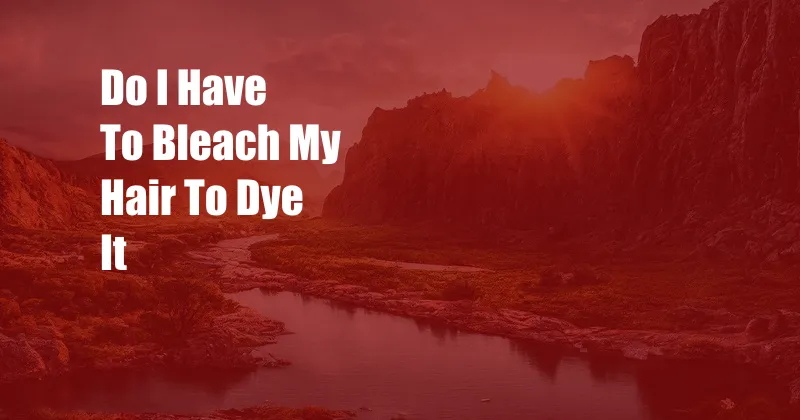
Do I Have to Bleach My Hair to Dye It?
In the realm of hair transformations, dyeing is an art form that can leave you with vibrant and head-turning locks. However, the process can be daunting, especially when it comes to achieving bold hues on darker hair. One common question that arises is whether bleaching is a necessary step. To shed light on this subject, let’s explore the world of hair dyeing, its intricacies, and the role of bleach.
Before embarking on your hair coloring journey, understanding the relationship between melanin and hair color is crucial. Melanin is the pigment responsible for giving our hair its natural color. Darker hair contains more melanin, while lighter hair has less. The amount of melanin present will influence the outcome of your dyeing efforts.
Can I Dye My Hair Without Bleaching?
The answer to this question depends on the desired outcome and your hair’s current color.
If you have light-colored hair (level 7 or higher on the hair color scale), you may not need to bleach your hair to achieve most shades. Lighter hair naturally contains less melanin, making it more receptive to color absorption. Direct dye or demi-permanent dyes can effectively deposit color on light hair without prior bleaching.
However, if you have darker hair (level 6 or lower on the hair color scale), bleaching may be necessary to lift the melanin and create a base for the new color. Bleaching removes melanin, allowing the dye to penetrate more deeply and achieve vibrant, long-lasting results. Without bleaching, darker hair may not be able to absorb the color effectively, resulting in dull or uneven results.
The Art of Bleaching
Bleach is an essential tool for achieving vibrant hair colors on darker hair. It contains peroxide, a chemical that breaks down melanin and lifts the hair’s natural color. The process of bleaching can be tailored to your desired level of lift. For instance, if you want subtle highlights and dimension, a low-volume peroxide can be used. If you’re aiming for a drastic transformation to a light blonde or vibrant hue, a higher-volume peroxide may be necessary.
Bleaching is a delicate process that should be carried out by a professional hairstylist. Improper bleaching can lead to hair damage, breakage, and scalp irritation. To ensure optimal results and minimize the risk of damage, enlist the expertise of a skilled colorist who can assess your hair’s health, determine the best bleaching technique, and provide aftercare instructions.
Tips and Expert Advice for Dyeing Your Hair
Before embarking on your hair dyeing adventure, consider the following tips and expert advice:
- Do a strand test first. This will help you preview the color result and assess your hair’s reaction to the dye.
- Start with a lower volume of peroxide. You can gradually increase the volume as needed to achieve the desired level of lift.
- Use a deep conditioner after bleaching. This will help restore moisture and prevent hair damage.
- Don’t over-bleach your hair. Repeat bleaching sessions should be spaced out to minimize damage.
- Consider using a color-depositing conditioner. This can help maintain your color between dye sessions and enhance vibrancy.
FAQs on Bleaching and Hair Dyeing
Q: Can I bleach my hair at home?
A: While home bleaching kits are available, it’s highly recommended to have your hair bleached by a professional hairstylist to ensure proper technique and minimize damage.
Q: How often should I bleach my hair?
A: The frequency of bleaching depends on your hair’s health and the desired color result. Consult with your hairstylist to determine an appropriate bleaching schedule.
Q: Will bleaching damage my hair?
A: Bleaching can cause some damage to your hair, but following proper techniques and using nourishing hair care products can help minimize the risk.
Conclusion
The decision of whether or not to bleach your hair before dyeing depends on your desired color result and your hair’s current color. If you have light-colored hair, you may be able to achieve your desired color without bleaching. However, if you have darker hair, bleaching may be necessary to create a foundation for vibrant color absorption.
Remember, bleaching is a process that should be handled by a professional to ensure optimal results and minimize damage. By following the tips and expert advice provided, you can navigate the world of hair dyeing with confidence and achieve the stunning transformation you desire.
Are you interested in learning more about hair dyeing techniques? Visit our website or contact a professional hairstylist to explore your options and embark on a vibrant hair journey.